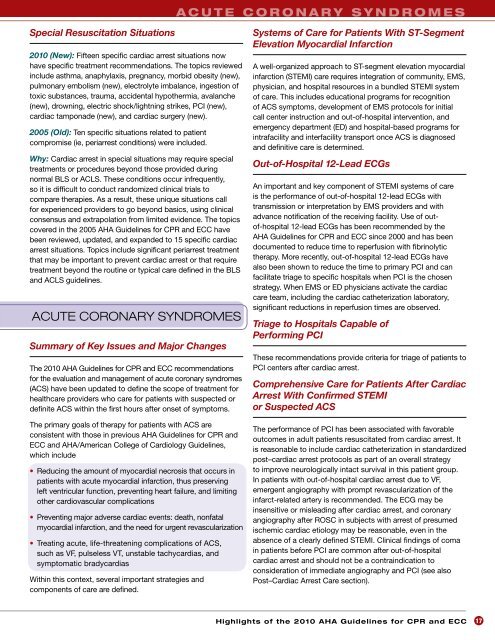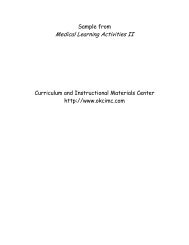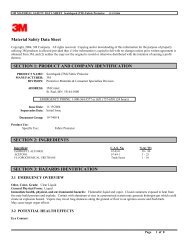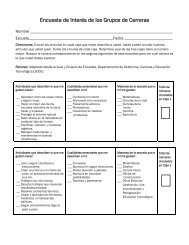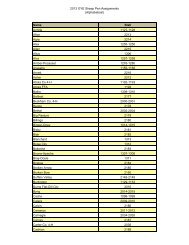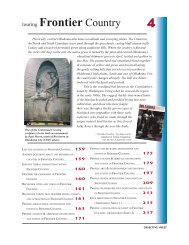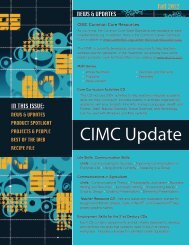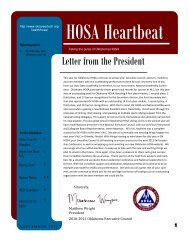Highlights of the 2010 Guidelines for CPR and ECC - ECC Guidelines
Highlights of the 2010 Guidelines for CPR and ECC - ECC Guidelines
Highlights of the 2010 Guidelines for CPR and ECC - ECC Guidelines
You also want an ePaper? Increase the reach of your titles
YUMPU automatically turns print PDFs into web optimized ePapers that Google loves.
a c u t e c o r o n a r y s y n d r o m e s<br />
Special Resuscitation Situations<br />
<strong>2010</strong> (New): Fifteen specific cardiac arrest situations now<br />
have specific treatment recommendations. The topics reviewed<br />
include asthma, anaphylaxis, pregnancy, morbid obesity (new),<br />
pulmonary embolism (new), electrolyte imbalance, ingestion <strong>of</strong><br />
toxic substances, trauma, accidental hypo<strong>the</strong>rmia, avalanche<br />
(new), drowning, electric shock/lightning strikes, PCI (new),<br />
cardiac tamponade (new), <strong>and</strong> cardiac surgery (new).<br />
2005 (Old): Ten specific situations related to patient<br />
compromise (ie, periarrest conditions) were included.<br />
Why: Cardiac arrest in special situations may require special<br />
treatments or procedures beyond those provided during<br />
normal BLS or ACLS. These conditions occur infrequently,<br />
so it is difficult to conduct r<strong>and</strong>omized clinical trials to<br />
compare <strong>the</strong>rapies. As a result, <strong>the</strong>se unique situations call<br />
<strong>for</strong> experienced providers to go beyond basics, using clinical<br />
consensus <strong>and</strong> extrapolation from limited evidence. The topics<br />
covered in <strong>the</strong> 2005 AHA <strong>Guidelines</strong> <strong>for</strong> <strong>CPR</strong> <strong>and</strong> <strong>ECC</strong> have<br />
been reviewed, updated, <strong>and</strong> exp<strong>and</strong>ed to 15 specific cardiac<br />
arrest situations. Topics include significant periarrest treatment<br />
that may be important to prevent cardiac arrest or that require<br />
treatment beyond <strong>the</strong> routine or typical care defined in <strong>the</strong> BLS<br />
<strong>and</strong> ACLS guidelines.<br />
ACUTE CORONARY SYNDROMES<br />
Summary <strong>of</strong> Key Issues <strong>and</strong> Major Changes<br />
The <strong>2010</strong> AHA <strong>Guidelines</strong> <strong>for</strong> <strong>CPR</strong> <strong>and</strong> <strong>ECC</strong> recommendations<br />
<strong>for</strong> <strong>the</strong> evaluation <strong>and</strong> management <strong>of</strong> acute coronary syndromes<br />
(ACS) have been updated to define <strong>the</strong> scope <strong>of</strong> treatment <strong>for</strong><br />
healthcare providers who care <strong>for</strong> patients with suspected or<br />
definite ACS within <strong>the</strong> first hours after onset <strong>of</strong> symptoms.<br />
The primary goals <strong>of</strong> <strong>the</strong>rapy <strong>for</strong> patients with ACS are<br />
consistent with those in previous AHA <strong>Guidelines</strong> <strong>for</strong> <strong>CPR</strong> <strong>and</strong><br />
<strong>ECC</strong> <strong>and</strong> AHA/American College <strong>of</strong> Cardiology <strong>Guidelines</strong>,<br />
which include<br />
• Reducing <strong>the</strong> amount <strong>of</strong> myocardial necrosis that occurs in<br />
patients with acute myocardial infarction, thus preserving<br />
left ventricular function, preventing heart failure, <strong>and</strong> limiting<br />
o<strong>the</strong>r cardiovascular complications<br />
• Preventing major adverse cardiac events: death, nonfatal<br />
myocardial infarction, <strong>and</strong> <strong>the</strong> need <strong>for</strong> urgent revascularization<br />
• Treating acute, life-threatening complications <strong>of</strong> ACS,<br />
such as VF, pulseless VT, unstable tachycardias, <strong>and</strong><br />
symptomatic bradycardias<br />
Within this context, several important strategies <strong>and</strong><br />
components <strong>of</strong> care are defined.<br />
Systems <strong>of</strong> Care <strong>for</strong> Patients With ST-Segment<br />
Elevation Myocardial Infarction<br />
A well-organized approach to ST-segment elevation myocardial<br />
infarction (STEMI) care requires integration <strong>of</strong> community, EMS,<br />
physician, <strong>and</strong> hospital resources in a bundled STEMI system<br />
<strong>of</strong> care. This includes educational programs <strong>for</strong> recognition<br />
<strong>of</strong> ACS symptoms, development <strong>of</strong> EMS protocols <strong>for</strong> initial<br />
call center instruction <strong>and</strong> out-<strong>of</strong>-hospital intervention, <strong>and</strong><br />
emergency department (ED) <strong>and</strong> hospital-based programs <strong>for</strong><br />
intrafacility <strong>and</strong> interfacility transport once ACS is diagnosed<br />
<strong>and</strong> definitive care is determined.<br />
Out-<strong>of</strong>-Hospital 12-Lead ECGs<br />
An important <strong>and</strong> key component <strong>of</strong> STEMI systems <strong>of</strong> care<br />
is <strong>the</strong> per<strong>for</strong>mance <strong>of</strong> out-<strong>of</strong>-hospital 12-lead ECGs with<br />
transmission or interpretation by EMS providers <strong>and</strong> with<br />
advance notification <strong>of</strong> <strong>the</strong> receiving facility. Use <strong>of</strong> out<strong>of</strong>-hospital<br />
12-lead ECGs has been recommended by <strong>the</strong><br />
AHA <strong>Guidelines</strong> <strong>for</strong> <strong>CPR</strong> <strong>and</strong> <strong>ECC</strong> since 2000 <strong>and</strong> has been<br />
documented to reduce time to reperfusion with fibrinolytic<br />
<strong>the</strong>rapy. More recently, out-<strong>of</strong>-hospital 12-lead ECGs have<br />
also been shown to reduce <strong>the</strong> time to primary PCI <strong>and</strong> can<br />
facilitate triage to specific hospitals when PCI is <strong>the</strong> chosen<br />
strategy. When EMS or ED physicians activate <strong>the</strong> cardiac<br />
care team, including <strong>the</strong> cardiac ca<strong>the</strong>terization laboratory,<br />
significant reductions in reperfusion times are observed.<br />
Triage to Hospitals Capable <strong>of</strong><br />
Per<strong>for</strong>ming PCI<br />
These recommendations provide criteria <strong>for</strong> triage <strong>of</strong> patients to<br />
PCI centers after cardiac arrest.<br />
Comprehensive Care <strong>for</strong> Patients After Cardiac<br />
Arrest With Confirmed STEMI<br />
or Suspected ACS<br />
The per<strong>for</strong>mance <strong>of</strong> PCI has been associated with favorable<br />
outcomes in adult patients resuscitated from cardiac arrest. It<br />
is reasonable to include cardiac ca<strong>the</strong>terization in st<strong>and</strong>ardized<br />
post–cardiac arrest protocols as part <strong>of</strong> an overall strategy<br />
to improve neurologically intact survival in this patient group.<br />
In patients with out-<strong>of</strong>-hospital cardiac arrest due to VF,<br />
emergent angiography with prompt revascularization <strong>of</strong> <strong>the</strong><br />
infarct-related artery is recommended. The ECG may be<br />
insensitive or misleading after cardiac arrest, <strong>and</strong> coronary<br />
angiography after ROSC in subjects with arrest <strong>of</strong> presumed<br />
ischemic cardiac etiology may be reasonable, even in <strong>the</strong><br />
absence <strong>of</strong> a clearly defined STEMI. Clinical findings <strong>of</strong> coma<br />
in patients be<strong>for</strong>e PCI are common after out-<strong>of</strong>-hospital<br />
cardiac arrest <strong>and</strong> should not be a contraindication to<br />
consideration <strong>of</strong> immediate angiography <strong>and</strong> PCI (see also<br />
Post–Cardiac Arrest Care section).<br />
<strong>Highlights</strong> <strong>of</strong> <strong>the</strong> <strong>2010</strong> AHA <strong>Guidelines</strong> <strong>for</strong> <strong>CPR</strong> <strong>and</strong> <strong>ECC</strong><br />
17


